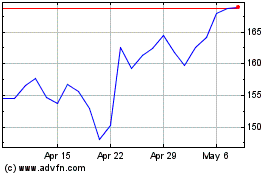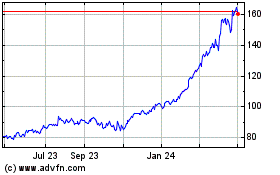By Ryan Tracy and Ted Mann
WASHINGTON -- General Electric Co.'s lending arm became the
first big financial institution to escape stricter post-crisis
rules by sharply shrinking, in what could be a sign of things to
come for other titans of finance.
The U.S. Financial Stability Oversight Council said Wednesday
that it voted this week to remove its label on GE Capital as
"systemically important financial institution," which carries more
stringent oversight. Treasury Secretary Jacob Lew, who chairs the
council, said the change shows that designation is a "two-way
process" -- a rebuttal to critics who have said its process for
branding "systemic" firms is opaque and doesn't give firms a clear
road map on how to reduce risk.
GE said about a year ago, in April 2015, that it would seek to
have its status changed, as it decided to pivot away from financial
services and sell off most of GE Capital, what was then its $500
billion lending business and one of the largest banking businesses
in the U.S.
GE Chief Executive Jeff Immelt said changed market conditions
and new regulations had caused GE Capital's returns to fall below
its cost of capital. And investors had long urged Mr. Immelt to get
out of the lending business, which nearly sunk the entire company
during the financial crisis.
Since deciding to wind down the finance arm, GE Capital has
signed agreements for the sale of about $180 billion of businesses
and has closed about $156 billion of those transactions. The head
of GE Capital, Keith Sherin, said the decision by regulators is a
result of the transformation of GE Capital into a "smaller, safer
financial services company."
GE shares rose 1.7% to $30.46 in afternoon trading.
While the move is a big win for GE, it's also a victory the
Obama administration and its vision for how finance should be
overseen. While resisting populist political pressure to simply
break up big financial institutions, regulators have used various
powers and pressures to encourage firms to shrink themselves and
reduce their complexity and risk-taking. In addition to using the
"systemically important" label to do so, regulators have required
big banks to hold more capital on their books, and have continued
to add "surcharges" for the very biggest banks, essentially
imposing a tax on size.
The GE case marks the first time the oversight council has
removed the "systemically important financial institution," or
SIFI, tag since it was created under the 2010 Dodd-Frank financial
overhaul law. "The Council follows the facts: When it identifies a
company that could threaten financial stability, it acts; when
those risks change, the Council also acts," Mr. Lew said. He said
the council conducted a "methodological analysis" of GE Capital and
determined it is "significantly smaller and safer, with more stable
funding."
The decision comes as FSOC -- a committee made up of senior U.S.
regulators and officials including heads of the Federal Reserve and
the Securities and Exchange Commission -- is caught in the middle
of both legal and political battles challenging its authority. It
was designed to give regulators new powers to impose bank-like
supervision and safeguards on the types of nonbank firms, such as
American International Group Inc., that helped fuel the global
market meltdown.
On the legal front, FSOC is appealing a March federal judge
ruling nullifying its authority to impose the "systemically
important" label on insurance giant MetLife Inc. The stakes are
seen as so high that the government case has drawn supporting
briefs from an all-star cast of financial crisis-era policy makers,
including former Federal Reserve Chairs Ben Bernanke and Paul
Volcker, and former lawmakers Chris Dodd and Barney Frank, the
co-authors of the 2010 Dodd-Frank Act that created FSOC.
Meantime, Republicans in Congress are moving legislation that
would replace Dodd-Frank, including provisions that would scale
back FSOC's authority to designate firms as SIFIs.
Wednesday's announcement leaves two nonbank firms with the
systemically important label, as opposed to four just a few months
ago. Huge insurers Prudential Financial Inc. and American
International Group Inc. also received the label in 2013 are still
considered systemically important, meaning they are overseen by the
Fed and face stricter rules than their peers.
MetLife was designated in late 2014, but its court victory
nullified that status, pending the government's appeal.
GE Capital's success at rescinding the label by appealing
directly to the oversight council could lead Prudential or AIG to
follow a similar path. The council is required to review the labels
annually under Dodd-Frank.
Separately, some investors are pressuring some of the
SIFIs--both banks and nonbanks--to follow GE's strategy of shedding
assets and shrinking to persuade they government they don't pose a
threat to financial system.
While GE Capital has shown it is possible to convince regulators
to rescind the SIFI label, the specifics of its case don't
necessarily apply to other firms.
In an explanation of its decision, the oversight council noted
that GE Capital had divested about $272 billion of assets since
2012, cut its use of short-term funding sources by 86% and
reorganized its legal structure in a way that would make its
failure more orderly. Regulators also liked the fact that GE
decided to guarantee GE Capital's debt, making it less likely that
lenders to the latter firm would come under duress.
Other firms don't have a parent like GE, or might not be able to
restructure on such an immense scale.
Over the past year, GE has narrowed its focus to high-tech
industrial products like jet engines, power turbines, locomotives
and medical scanners and, since announcing its plan to exit
financial services last April, has sold off GE Capital in chunks,
dispersing its operations sector by sector, often to some of its
chief competitors.
GE unloaded more than $30 billion in real estate and also sold
its North American commercial lending business, which had about $30
billion in assets, to Wells Fargo last fall, among other
operations
GE formally asked for the label to be removed in March, and met
with the council staff during April and May, the Treasury
Department said.
Still, major financial services operations will remain at GE.
The company is holding onto its profitable business that leases
aircraft and finances jet engine purchases. It is also retaining
its energy industry finance unit and a rechristened industrial
finance unit that will handle capital needs for the company's
manufacturing businesses as well as its health-care financing. In
all, the reconfigured GE finance operation will have about $80
billion in assets, Mr. Sherin said in an interview. Overall, the
share of GE's profits from lending will drop substantially,
however, from about half in the middle of the last decade, to less
than 10% of total earnings by 2017, the company says.
Shedding the SIFI tag means GE can fully wind down the
regulatory infrastructure that it built up in the years after it
was first put under supervision by the Fed.
It can also reduce its capital ratio below the 14% it had agreed
on with the Fed at the outset of the wind-down plan--a step that
will enable GE Capital to meet its goal of sending $18 billion in
capital back up to the parent company.
"Now that we have exited Fed supervision, we are going to
re-evaluate that level and I'm sure it's going to be lower than
that," Mr. Sherin said.
GE may also be able to add more debt to its balance sheet as
Nelson Peltz's Trian Fund called for when the activist investor
took a $2.5 billion stake in the conglomerate last year. Executives
have been waiting to get out from under Fed oversight to explore
such moves.
Write to Ryan Tracy at ryan.tracy@wsj.com and Ted Mann at
ted.mann@wsj.com
(END) Dow Jones Newswires
June 29, 2016 13:25 ET (17:25 GMT)
Copyright (c) 2016 Dow Jones & Company, Inc.
GE Aerospace (NYSE:GE)
Historical Stock Chart
From Mar 2024 to Apr 2024

GE Aerospace (NYSE:GE)
Historical Stock Chart
From Apr 2023 to Apr 2024
